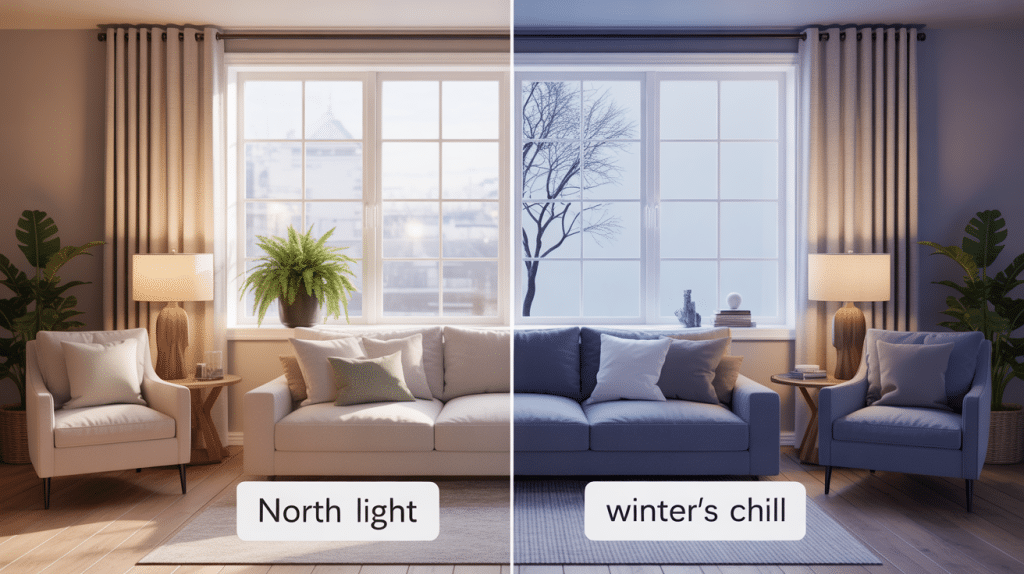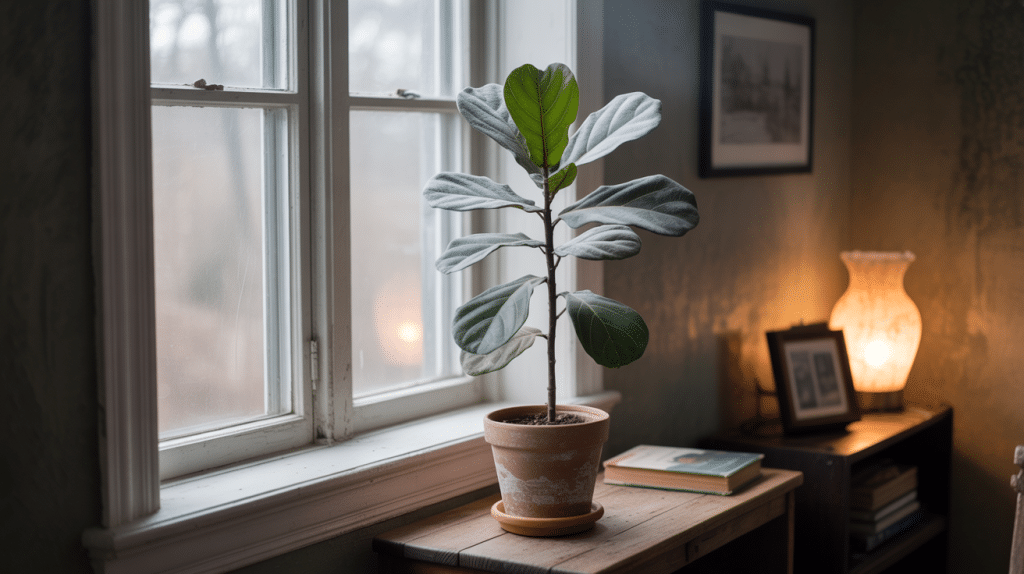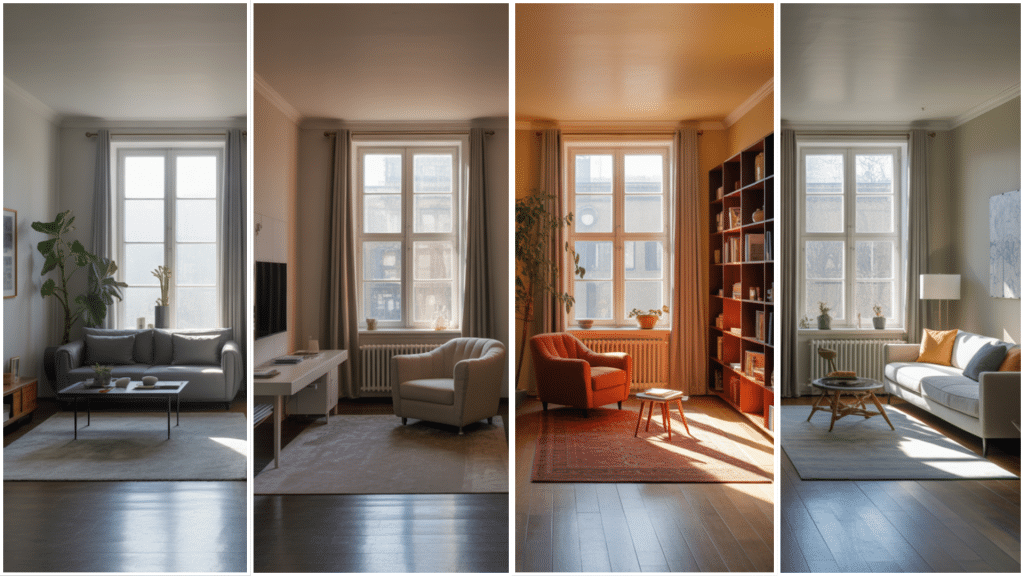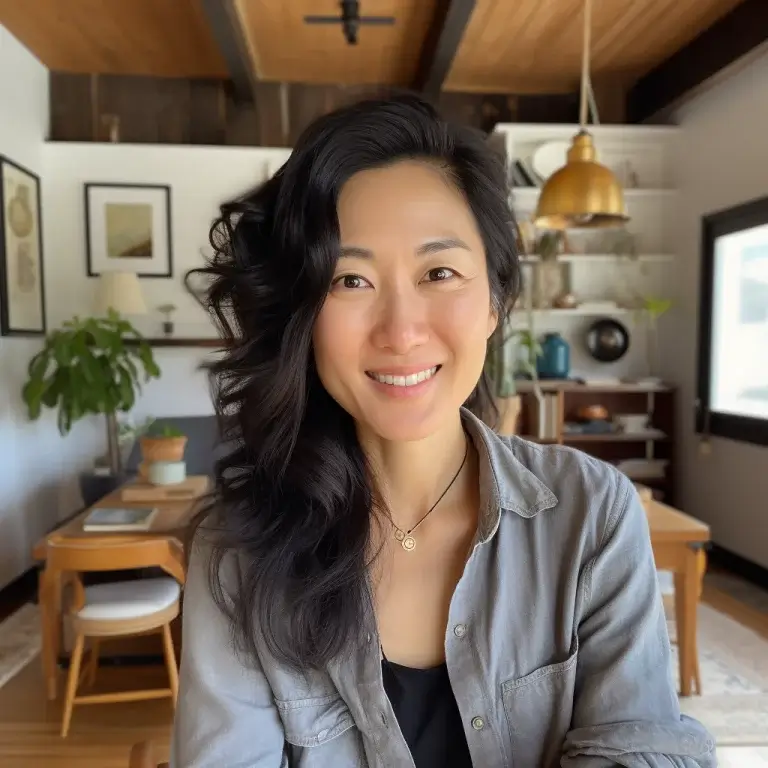Every homeowner can master the art of working with north-facing windows once they understand the basics. These windows create unique lighting conditions that many people overlook or struggle with unnecessarily.
The key lies in knowing how to work with their natural characteristics rather than against them. Savvy homeowners recognize that north-facing windows offer distinct advantages.
Understanding their lighting patterns and energy effects empowers anyone to make informed design decisions.
This guide provides all the practical knowledge needed to turn potential challenges into design strengths.
Armed with the right information, homeowners can confidently plan rooms, choose colors, and select treatments that maximize these windows’ benefits.
What Are North-Facing Windows?
Window orientation refers to the compass direction a window faces from inside the home.
North-facing windows point toward the northern sky and receive fundamentally different sunlight patterns than other directions throughout the day.
These windows get the least amount of direct sunlight because the sun travels across the southern sky in most locations.
This creates steady, indirect lighting conditions that remain remarkably consistent from morning to evening.
The predictable nature of this lighting makes north-facing windows behave differently than east, south, or west-facing alternatives.
Lighting Conditions with North-Facing Windows

Understanding the specific lighting characteristics helps homeowners plan their spaces effectively. North-facing windows create predictable conditions that differ significantly from other orientations.
1. Consistent, Soft, Indirect Light
North-facing windows provide steady, gentle light throughout the day with minimal direct sunlight exposure.
The illumination remains constant without dramatic changes seen in other orientations. Rooms stay comfortably lit without bright spots or deep shadows.
This makes north-facing spaces ideal for activities requiring consistent visibility.
2. Color and Mood Effects
North-facing rooms have cooler, blue-toned light that influences how colors appear in the space. Paint colors may look different from what is expected.
Warm colors appear muted while cool colors seem more vibrant. The lighting creates a calm atmosphere that many find soothing.
However, some homeowners feel these spaces lack the cheerful warmth of sun-filled rooms.
3. Seasonal Variations and Daily Patterns
North-facing windows maintain gentle lighting year-round, but intensity levels change with seasons.
Winter brings dimmer conditions, while summer provides brighter, indirect light that lasts longer.
Unlike other orientations, these windows don’t experience dramatic daily shifts in light direction or intensity.
Benefits and Drawbacks of North-Facing Windows
North-facing windows offer several practical advantages that savvy homeowners can leverage in their design plans.
However, understanding both the benefits and limitations helps homeowners make informed decisions about their use.
Benefits

Smart homeowners can turn north-facing windows into valuable assets when they understand their unique advantages.
These windows provide specific benefits that make them ideal for certain rooms and situations.
- Perfect workspace lighting – Art studios, home offices, and craft rooms thrive with consistent, glare-free light that prevents eye strain. Computer screens stay visible without reflections while artists get true color representation throughout the day.
- Energy savings year-round – These windows act like natural air conditioning by blocking direct summer heat that forces cooling systems to work overtime. The stable conditions lead to lower utility bills and longer HVAC system life.
- Interior protection that pays off – Furniture, flooring, and artwork stay vibrant longer because harmful UV rays can’t reach them directly. This natural protection saves thousands in replacement costs over time, making these windows a smart financial investment.
Drawbacks

While north-facing windows offer clear advantages, homeowners should also consider their limitations before making design decisions.
Understanding these challenges helps homeowners prepare appropriate solutions and set realistic expectations.
- Less natural heating in winter: Minimal passive solar gain means rooms may feel cooler, especially during winter months. Additional heating or insulation may be necessary in colder climates, potentially increasing energy costs.
- Lower light intensity overall: Some rooms may feel dim or require supplemental artificial lighting, particularly in larger spaces or during winter. Reading, detailed work, or cooking may need extra light sources to compensate.
- Limited plant growing options: The lack of direct sunlight makes it challenging to grow sun-loving indoor plants successfully. Many popular houseplants need several hours of direct light daily to thrive and bloom properly.
Tips for Maximizing North-Facing Windows
Homeowners can transform north-facing spaces into bright, welcoming areas with the right design strategies. These proven techniques help overcome common challenges while highlighting the natural benefits.
| Strategy | How to Implement | Benefits |
|---|---|---|
| Choose lighter, warmer paint colors | Use cream, warm white, and soft yellow tones throughout the room | Counteracts cool light and makes spaces feel more inviting and cheerful |
| Install larger windows when possible | Consider upgrading to bigger sizes during renovations | Captures more available indirect light throughout the day for better illumination |
| Add mirrors and reflective surfaces strategically | Place mirrors across from windows, and use glossy furniture finishes | Doubles the apparent light in the room and helps bounce illumination around |
| Layer window treatments for flexibility | Combine cellular shades with decorative panels that open during the day | Maintains energy efficiency without sacrificing precious natural light |
| Focus on energy-efficient window upgrades | Install double or triple-pane windows with low-E coatings | Reduces heat loss while maintaining excellent light transmission year-round |
North-Facing Windows vs. Other Orientations

Understanding how different orientations compare helps homeowners make informed decisions about window placement and room functions.
| Orientation | Sunlight Exposure | Best For | Pros | Cons |
|---|---|---|---|---|
| North | Soft, indirect, consistent | Studios, offices, bedrooms | Even light, energy-efficient | Less heat may feel dim |
| South | Direct, all-day sun | Living rooms, kitchens | Warmth in winter, bright light | Can overheat in summer |
| East | Morning sunlight | Bedrooms, breakfast nooks | Gentle morning light | Dims after midday |
| West | Afternoon/evening sun | Living, entertainment spaces | Warm evening glow | Overheating, glare |
Conclusion
North-facing windows offer unique qualities that work well in the right situations. Their consistent soft light, energy efficiency, and design flexibility make them valuable for specific room types.
The gentle illumination protects interiors while creating calm, comfortable environments. Successful design depends on understanding both the benefits and limitations of this orientation.
Use lighter colors, larger windows, and reflective surfaces to maximize the available light. Consider your climate, lifestyle, and room function when planning window placement.
Share your design tips and solutions in the comments below to help other homeowners make the most of their lighting conditions.
With the right approach, north-facing windows become assets that enhance both comfort and home value.


